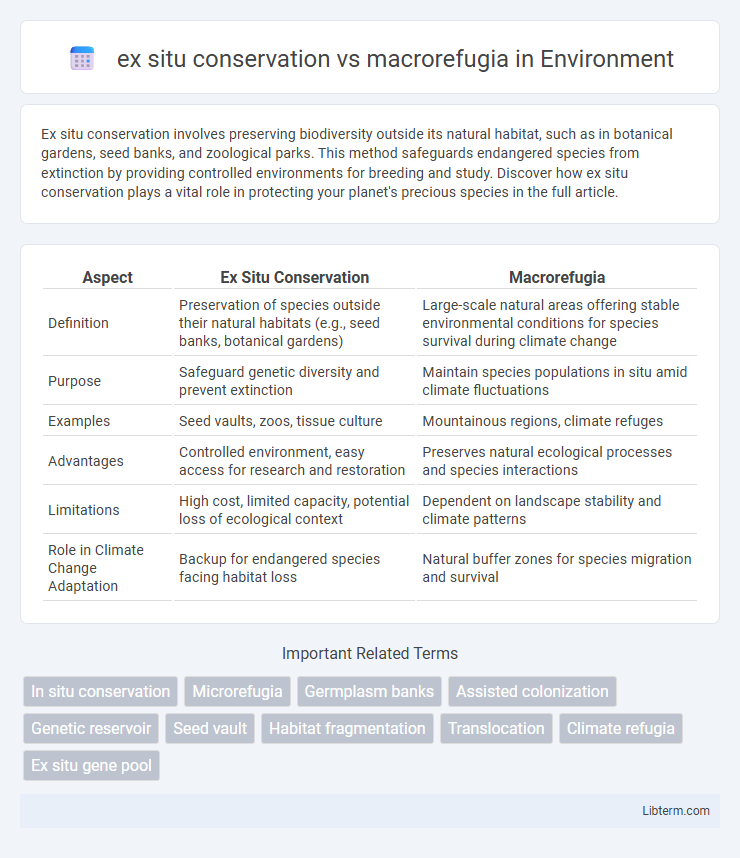Ex situ conservation involves preserving biodiversity outside its natural habitat, such as in botanical gardens, seed banks, and zoological parks. This method safeguards endangered species from extinction by providing controlled environments for breeding and study. Discover how ex situ conservation plays a vital role in protecting your planet's precious species in the full article.
Table of Comparison
| Aspect | Ex Situ Conservation | Macrorefugia |
|---|---|---|
| Definition | Preservation of species outside their natural habitats (e.g., seed banks, botanical gardens) | Large-scale natural areas offering stable environmental conditions for species survival during climate change |
| Purpose | Safeguard genetic diversity and prevent extinction | Maintain species populations in situ amid climate fluctuations |
| Examples | Seed vaults, zoos, tissue culture | Mountainous regions, climate refuges |
| Advantages | Controlled environment, easy access for research and restoration | Preserves natural ecological processes and species interactions |
| Limitations | High cost, limited capacity, potential loss of ecological context | Dependent on landscape stability and climate patterns |
| Role in Climate Change Adaptation | Backup for endangered species facing habitat loss | Natural buffer zones for species migration and survival |
Introduction to Ex Situ Conservation and Macrorefugia
Ex situ conservation involves preserving species outside their natural habitats, such as in seed banks, botanical gardens, or zoos, ensuring genetic diversity and safeguarding against extinction. Macrorefugia refer to large-scale natural areas that provide stable environmental conditions allowing species to survive climate change or habitat disturbances over long periods. Both strategies are crucial in biodiversity preservation, with ex situ conservation offering controlled protection while macrorefugia support natural resilience and species persistence in situ.
Defining Ex Situ Conservation: Strategies and Objectives
Ex situ conservation involves preserving genetic resources outside their natural habitats, typically through seed banks, botanical gardens, and gene banks, to safeguard biodiversity against habitat loss and climate change. Strategies focus on collecting, maintaining, and regenerating germplasm to ensure long-term survival and availability for restoration or research. Objectives include protecting endangered species, supporting reintroduction programs, and maintaining genetic diversity for future adaptability and resilience.
Understanding Macrorefugia: Role in Species Survival
Macrorefugia provide critical large-scale habitats that support species survival by offering stable environmental conditions during climate fluctuations, ensuring long-term persistence. Unlike ex situ conservation, which involves preserving species outside their natural habitats, macrorefugia maintain ecological interactions and evolutionary processes in situ. These areas are essential for conserving biodiversity under changing climates due to their capacity to buffer species against adverse environmental shifts.
Historical Context of Both Conservation Methods
Ex situ conservation emerged prominently in the early 20th century with botanical gardens and seed banks designed to preserve genetic diversity outside natural habitats. Macrorefugia, a concept rooted in paleoclimatology and ecology, gained attention in the late 20th century as researchers identified large stable areas that protected species during past climate fluctuations. Both approaches reflect evolving conservation strategies shaped by scientific advancements and shifting priorities in biodiversity preservation.
Key Differences Between Ex Situ Conservation and Macrorefugia
Ex situ conservation involves preserving species outside their natural habitats, such as in seed banks, botanical gardens, or zoos, ensuring genetic diversity is maintained under controlled conditions. Macrorefugia refer to large natural areas that provide stable environmental conditions, allowing species to survive climate change and other ecological threats in situ. Key differences include the controlled environment of ex situ conservation versus the natural habitat reliance of macrorefugia, with ex situ focusing on active management and macrorefugia offering passive protection through habitat stability.
Comparative Advantages and Limitations
Ex situ conservation offers controlled environments for preserving genetic diversity of endangered species, enabling seed banks and botanical gardens to safeguard against habitat loss, yet it often lacks ecological interactions vital for species adaptation. Macrorefugia provide large-scale natural habitats that support ecosystem resilience and species migration under climate change, but their effectiveness can be limited by habitat fragmentation and human encroachment. Balancing the precision of ex situ methods with the ecological benefits of macrorefugia is crucial for integrated biodiversity conservation strategies.
Case Studies: Ex Situ Conservation Successes
Ex situ conservation strategies, such as seed banks and botanical gardens, have demonstrated notable success in preserving genetic diversity and supporting species recovery. For instance, the Millennium Seed Bank Partnership has safeguarded over 2 billion seeds from 40,000 plant species, enabling restoration projects globally. These case studies highlight the effectiveness of controlled environments in maintaining biodiversity compared to macrorefugia, which rely on natural habitats to buffer species against climate change.
Notable Examples of Macrorefugia Applications
Macrorefugia have been effectively utilized in preserving biodiversity amid climate change, with notable examples including the Appalachian Mountains in North America, which serve as climate-stable refuges for diverse plant and animal species. In Europe, the Carpathian Mountains act as macrorefugia, supporting species that cannot survive in altered lowland habitats by providing cooler microclimates and stable environmental conditions. These natural strongholds complement ex situ conservation methods by maintaining viable populations in situ, enabling ecosystems to adapt and persist over time.
Integrating Ex Situ and Macrorefugia Approaches
Integrating ex situ conservation with macrorefugia strategies enhances biodiversity preservation by combining seed banks and living collections with large-scale climate refuge areas to safeguard species against habitat loss and climate change. This synergy allows genetic diversity to be maintained in controlled environments while supporting natural evolutionary processes in macrorefugia, optimizing adaptation potential. Coordinated efforts improve long-term species survival by linking in situ resilience with ex situ resource security.
Future Directions and Policy Implications
Ex situ conservation strategies must integrate advanced biotechnologies to preserve genetic diversity and support species recovery under climate stress, while macrorefugia research requires enhanced spatial modeling to identify and protect climate-resilient habitats at landscape scales. Policies should promote synergistic frameworks that combine ex situ gene banks with in situ protection of macrorefugia to ensure adaptive capacity and long-term ecosystem stability. Future directions emphasize cross-sector collaboration and increased funding for large-scale monitoring systems to track species shifts and efficacy of conservation corridors.
ex situ conservation Infographic

 libterm.com
libterm.com